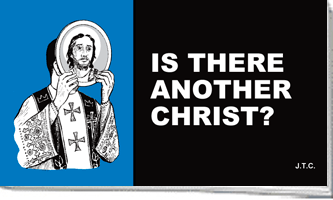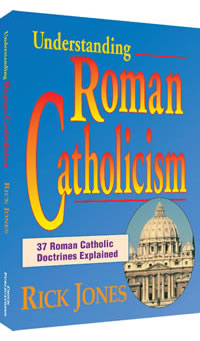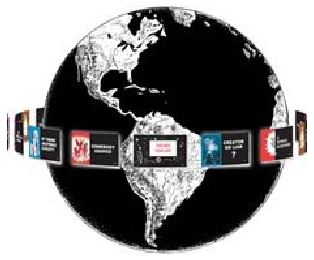Jesus Wafer Auctioned On Ebay; Priests Horrified
Three wheat wafers appeared for sale recently on online auction, eBay, and created a furor. One seller, in Britain, received bids in the millions of pounds before the listing was removed. No ordinary cookies, these were special because they had supposedly been "consecrated," turned into the "body, blood and divinity" of Jesus Christ by none other than the late Pope John Paul II.
Horrified Roman Catholic leaders immediately petitioned eBay to remove them from sale. One seller was in Sioux City, Iowa where no less than a Monsignor, Roger Augustine, persuaded the seller to remove the wafer from sale and give it to him, "who disposed of it properly."
So, how could a simple, round orb of wheat create such a stir? The answer is in the "consecration." Catholicism teaches that when a priest is "ordained," he receives the magical power to change the "substance" of the wafer into the actual "body, blood and divinity" of Jesus Christ.
Roman Catholics are taught that after this "change," the wafer should be worshipped, endued with such respect that any mishandling of it is considered blasphemy. Selling it for money would create a near ultimate horror in the heart of a good Catholic.
Ebay is now on the hot seat, trying to decide how to handle postings of all kinds of "sacred objects." It discovered that many other "relics" were being posted, some obviously bogus. A feather from the Holy Ghost, and a stone from the Virgin Mary's sepulcher have been offered for sale.
The worship of the communion wafer, known as the Eucharist, and the "veneration" of relics, illustrates a central idolatry of Roman Catholicism. According to the Catholic Encyclopedia online, "Idolatry etymologically denotes Divine worship given to an image, but its signification has been extended to all Divine worship given to anyone or anything but the true God.
With this definition, Catholics are bound to see the Eucharist as the "true God." Otherwise, it is idolatry. This places them in the awkward position of trying to defend the Eucharist against such blasphemy as eBay auctions. Furthermore, the leaders carry a heavy burden maintaining the superstition that what they place in the layman's mouth is actually Jesus Himself, when it still looks like a wafer.
A couple of stories told by Charles Chiniquy in his book, 50 Years in the Church of Rome, illustrate the point. He tells of a blind, aged priest who paused to adore the wafer while performing Mass and a rat ran off with it. The priest was inconsolable in his agony, believing that he had allowed a rat to run off with Jesus.
One of the duties of a priest is to carry the wafer (Chiniquy called it "The Good God") to the sick and dying. Chiniquy, himself, was stranded by nightfall on his way to give the wafer to a dying woman. He was housed by a farmer and left the next morning not realizing the container had slipped out of his coat pocket. When he returned for it, the family was in great turmoil. The wife had found the container and opened it to see what it contained.
When she did, she was standing over a chamber pot that the children used during the night and Jesus fell and sank to the bottom. Their agonizing was somewhat relieved when Chiniquy told them to dig a hole three feet deep and bury it, pot and all.
Today, we have trouble believing such superstition, yet at the beginning of 2005, Pope John Paul II declared this year the year of the Eucharist, giving tickets out of purgatory (indulgences) to anyone who worshipped the wafer for a certain length of time.
How much better it is to worship Jesus, Himself, in spirit and in truth, free from bondage to the pope's superstitions.
In the U.S. there are about 60 million precious souls who are relying on these superstitions for their eternal life. We need to help them see the Truth that will set them free.
- See more articles on related topics:
- Catholicism
- Eucharist
- Idolatry
Other Articles from November/December 2005:
- 'Jack the Ripper' Memorial Home For Battered Women?
- Protestants Gaining Millions in Africa and Latin America - Vatican Worried
- Ex-JW Sued for Watchtower Quotes
- Chick Mail Bag Nov-2005
- New Ruling Opens Prisons to More Gospel Literature
- Prison Ministry Letters: Nov-2005
- New Definition of Science?
- 'Stone Age' Another Evolution Myth
- Tract Passing Tips - November 2005
- But Was It a Waste of Time?
- Are Words Missing in the KJV?
More on Catholicism:
Products of Interest:

Is There Another Christ?
Have you ever been lied to? Millions have, trusting in "another Christ" to save them. The gospel for Roman Catholics.-

Answers To My Catholic Friends
64 pages
A gentle witness you can give Catholics that deals with venerating images, purgatory, where popes go when they die, and more. -

Understanding Roman Catholicism
224 pages
37 Catholic doctrines from the current Catechism are compared with the Scriptures. They're not Christian!



